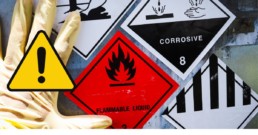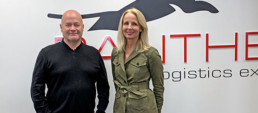The dangers of hazardous waste and how to do it safely
Introduction
Hazardous wastes are those which are dangerous and difficult to handle. If your business produces hazardous waste you have a duty of care to make sure it is disposed of properly.
Proper disposal of hazardous waste is crucial for the safety of people, animals, and the environment. Hazardous waste, if not handled correctly, can lead to severe health risks, contamination of soil and water, and dangerous chemical reactions. This document provides an in-depth understanding of the dangers associated with hazardous waste and offers guidelines on how to dispose of it safely.
The Dangers of Hazardous Waste
Hazardous waste encompasses many materials that pose significant risks due to their chemical composition, flammability, reactivity, or toxicity. Below are some of the primary dangers associated with hazardous waste:
Health Risks
- Exposure to Toxic Substances: Direct contact with hazardous waste can result in skin burns, respiratory problems, and poisoning. Many hazardous materials can be absorbed through the skin or inhaled, leading to serious health issues.
- Long-term Health Effects: Repeated exposure to certain hazardous materials, such as asbestos or heavy metals, can lead to chronic illnesses, including cancer, neurological disorders, and reproductive issues.
Environmental Impact
- Soil and Water Contamination: Hazardous waste can seep into the soil and groundwater, contaminating drinking water sources and agricultural land. This contamination can persist for years, affecting ecosystems and human health.
- Air Pollution: Improper disposal methods, such as incineration without appropriate controls, can release toxic fumes and particles into the air, contributing to air pollution and respiratory ailments.
Fire and Explosion Hazards
- Flammable Materials: Certain hazardous wastes, such as solvents and chemicals, are highly flammable and can easily ignite, causing fires and explosions that put lives and property at risk.
- Reactive Substances: Some hazardous materials can react violently with other substances, leading to dangerous situations that can result in explosions or release toxic gases.
How to Dispose of Hazardous Waste Safely
Safe disposal of hazardous waste requires adherence to specific regulations and best practices. Below are the key steps to ensure the safe handling and disposal of hazardous materials in commercial settings:
Identify Hazardous Waste
Properly identifying hazardous waste is the first step in ensuring its safe disposal. This involves:
- Labeling and Segregation: Label all hazardous materials and segregate them from non-hazardous waste. This helps prevent accidental mixing and ensures that each type of waste is handled appropriately.
- Understand hazardous materials, their properties, risks, and safe handling procedures.
- Further guidance for workplace health and safety can be found at The Health and Safety Executive (HSE).
Use of Appropriate Containers
The containers used for storing and transporting hazardous waste must be suitable for the specific type of waste, following all relevant regulations for proper storage and disposal. Key considerations include:
- Durability: Use durable containers that are resistant to the chemicals they will hold. This prevents leaks and spills.
- Sealing: Ensure containers are properly sealed and labelled to prevent the release of hazardous substances.
Compliance with Regulations
Adherence to regulations is essential for the safe disposal of hazardous waste:
- These regulations apply to those who produce, broker/deal, carry and receive hazardous waste to keep, treat or dispose of. Hazardous waste must be accompanied by correctly completed paperwork called a consignment note, or hazardous waste consignment note (HWCN). The note must be prepared before any hazardous waste is moved and is required for all movements of hazardous waste.
- Record-Keeping: Maintain accurate records of the types and quantities of hazardous waste generated, as well as the disposal methods used. These ensure the traceability of the waste from origin to disposal.
Training and Education
Educating employees about the dangers of hazardous waste and proper disposal methods is crucial for maintaining a safe work environment. Training programs should cover:
- Hazard Identification: Teach employees how to identify hazardous materials and understand their risks.
- Emergency Procedures: Train employees on emergency procedures in case of spills, leaks, or exposure to hazardous substances.
Working with Footprint Recycling
Working with a professional waste management company will ensure that hazardous waste is disposed of safely and in compliance with regulations. We have the expertise to handle hazardous waste safely and will ensure you have the right equipment for safely transporting, treating, and disposing of hazardous materials.
All businesses have a responsibility to dispose of hazardous waste safely. By understanding the dangers of hazardous waste and following best practices for its disposal, businesses can protect their employees, the public, and the environment. Proper identification, appropriate containers, regulatory compliance, professional waste management services, and employee training are all essential components of a comprehensive hazardous waste management strategy.
Call us on 01484 660770 or email our team if you'd like to find out more.
PANTHER PARTNERS WITH FOOTPRINT RECYCLING TO TAKE SUSTAINABILITY PLEDGE TO THE NEXT LEVEL
Leading two-person white glove delivery specialist Panther Group has joined forces with total waste management firm Footprint Recycling to help them reduce their carbon footprint, taking them a step closer to achieving their Net Zero pledge.
In recent years, as a part of its ESG pledge, Panther has vastly increased its commitment to improving its environmental impact by keeping its waste unpolluted and to a minimum by following best practices. They have increased recycling measures, conserved energy more efficiently, and used environmentally friendly technologies.
To take its commitment one step further, the business has even set a target to implement a zero-waste culture throughout every aspect of its operations.
Having provided a comprehensive range of sustainable waste and recycling solutions to a wide range of sectors since 2008, Footprint Recycling is passionate about helping businesses manage their waste, reduce their carbon footprints and achieve their sustainability goals.
Since partnering with recycling specialist Footprint, Panther has greatly improved their recycling and environmental credentials. To date this year alone, Panther has recycled more than 453 tonnes of cardboard, plastic, and expanded polystyrene, 226 tonnes of general waste, 144 tonnes of TVs, and over 50,000 old mattresses collected and recycled on behalf of its customers and 25,000 tonnes of metal from washing machine bodies also recycled. The company’s carbon footprint by installing energy-efficient LED lighting throughout the depots has also improved by 60%.
And ever mindful of the need to provide a ‘green’ ethical service, Panther provides a furniture recycling service and closely adheres to the WEEE Directive.
Panther can now boast that 80 percent of its waste is recycled – with an aim to increase that figure to 90 percent over the next 12 months.
As part of its long-term sustainable energy programme the company is collaborating with Ev3power and is considering solar, wind turbine, and hydrogen options to power its operations and are also considering electric and hydrogen options for its fleet.
In recent weeks Panther has conducted a number of electric vehicle trials and now boasts a forklift fleet that is 60 percent electric.
Guy Burgess, Logistics Director commented: “With combatting climate change currently at the forefront of the global agenda, we have chosen to partner with Footprint Recycling to further improve our environmental impact and make a positive difference to our ecosystem.
“As a business, we are already making huge strides in making long-term and sustainable changes by pushing sustainability in every aspect of the business. Ingraining environmental consciousness within the company’s culture and Footprint Recycling will be a fundamental driver in helping us to facilitate this.
“No longer is it acceptable for companies to provide a 'sustainability statement' as consumers are far savvier and more discerning about how they spend their money and what businesses they’re willing to support and trade with.
“More than that though it’s vital that as a growing business we respond to the current climate crisis and act accordingly. The government has set a pledge for the UK to achieve Net Zero status by 2050, and as a company that strives for sustainability, we want to join the fight against global warming by driving down our environmental impact over the coming years.”
Robyn Brook, Founder & Chief Executive Officer, Footprint Recycling commented: “Our business is built on a foundation of helping our customers embrace the circular economy and improve their sustainability with a focus on achieving zero waste to landfill through recycling and reducing emissions.
“With pressure on businesses, like Panther, to do more to minimise their environmental impacts, our aim is not only to manage waste but to challenge the industry norms by developing processes bespoke to each client and introducing new ways to reduce, reuse and recycle.
“We’ve been working with Panther for several years, over which we have developed a fantastic relationship that allows us to continually strive and look at new ways to help them improve their environmental credentials and assist with their sustainability journey.”


